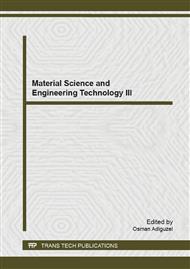[1]
T. Shimizu, T. Mori, M. Tomita and K. Tsumoto: Langmuir Vol. 30 (2014), pp.554-563.
Google Scholar
[2]
I. Drachuk, O. Shchepelina, S. Harbaugh, N. Kelley‐Loughnane, M. Stone and V.V. Tsukruk: Small Vol. 9 (2013), pp.3128-3137.
DOI: 10.1002/smll.201202992
Google Scholar
[3]
M.C. Koetting, N.A. Peppas: Int. J. Pharm. Vol. 471 (2014), pp.83-91.
Google Scholar
[4]
J. Yan, Y.Z. Du, F.Y. Chen, H. Yuan and F.Q. Hu: Mol. Pharmaceutics Vol. 10 (2013), pp.2568-2577.
Google Scholar
[5]
O. Germershaus, V. Werner, M. Kutscher and L. Meinel: Biomaterials Vol. 35 (2014), pp.3427-3434.
DOI: 10.1016/j.biomaterials.2013.12.083
Google Scholar
[6]
A.S. Nowacek, S. Balkundi, J.E. McMillan, U. Roy, A.M. Skinner, R.L. Mosely, G. Kanmogne, A.V. Kabanov, T. Bronich, H.E. Gendelman: J. Controlled Release Vol. 150 (2011), pp.204-211.
DOI: 10.1016/j.jconrel.2010.11.019
Google Scholar
[7]
C. Vepari, D.L. Kaplan: Prog. Polym. Sci. Vol. 32 (2007), pp.991-1007.
Google Scholar
[8]
Y. Cao, B. Wang: Int. J. Mol. Sci. Vol. 10 (2009), pp.1514-1524.
Google Scholar
[9]
L. Meinel, S. Hofmann, V. Karageorgiou, C. Kirker-Head, J. McCool, G. Gronowicz, L. Zichner, R. Langer, G. Vunjak-Novakovic, and D.L. Kaplan: Biomaterials Vol. 26 (2005), pp.147-155.
DOI: 10.1016/j.biomaterials.2004.02.047
Google Scholar
[10]
B. Kundu, N.E. Kurland, S. Bano, C. Patra, F.B. Engel, V.K. Yadavalli and S.C. Kundu: Prog: Polym. Sci. Vol. 39 (2014), pp.251-267.
DOI: 10.1016/j.progpolymsci.2013.09.002
Google Scholar
[11]
H. Mori, M. Tsukada: Rev. Mol. Biotechnol. Vol. 74 (2000), pp.95-103.
Google Scholar
[12]
G.H. Altman, F. Diaz, C. Jakuba, T. Calabro, R.L. Horan, J.S. Chen, H. Lu, J. Richmond and D.L. Kaplan: Biomaterials Vol. 24 (2003), pp.401-416.
DOI: 10.1016/s0142-9612(02)00353-8
Google Scholar
[13]
B. Kundu, R. Rajkhowa, S.C. Kundu and X.G. Wang: Adv. Drug Delivery Rev. Vol. 65 (2013), pp.457-470.
DOI: 10.1016/j.addr.2012.09.043
Google Scholar
[14]
P.Y. Wu, Q. Liu, R.T. Li, J. Wang, X. Zhen, G.F. Yue, H.Y. Wang, F.B. Cui, F.L. Wu, M. Yang, X.P. Qian, L.X. Yu, X.Q. Jiang, B.R. Liu: ACS Appl. Mater. Interfaces Vol. 5 (2013), pp.12638-12645.
DOI: 10.1021/am403992b
Google Scholar
[15]
T. Yucel, M.L. Lovett, D.L. Kaplan: J. Controlled Release Vol. (2014).
Google Scholar
[16]
R. Elia, D.R. Newhide, P.D. Pedevillano, G.R. Reiss, M.A. Firpo, E.W. Hsu, D.L. Kaplan, G.D. Prestwich, R.A. Peattie and R.A. Peattie: J. Biomater. Appl. Vol. 27 (2013), pp.749-762.
DOI: 10.1177/0885328211424516
Google Scholar
[17]
M.A. Marin, R.R. Mallepally, M.A. McHugh: J. Supercrit. Fluid. Vol. 91 (2014), pp.84-89.
Google Scholar
[18]
J. He, Y. Cheng, S. Cui: J. Appl. Polym. Sci. Vol. 128 (2013), pp.1081-1088.
Google Scholar
[19]
K. Lee, H.Y. Kweon, J. Yeo, S. Woo, S. Han and J.H. Kim: Int. J. Biol. Macromol. Vol. 48 (2011), pp.223-226.
Google Scholar
[20]
X.F. Li, C. Zhang, L.S. Wang, C.L. Ma, W.C. Yang and M.Z. Li: J. Chem. Vol. (2013).
Google Scholar
[21]
C.X. Zhao, X.F. Wu, Q. Zhang, S.Q. Yan and M.Z. Li: Int. J. Biol. Macromol. Vol. 48 (2011), pp.249-255.
Google Scholar
[22]
A. Tandle, D.G. Blazer, S.K. Libutti: J. Transl. Med. Vol. 2 (2004), p.22.
Google Scholar
[23]
Y. Liu, R.C. You, G.Y. Liu, X.F. Li, S.W. Sheng, J.C. Yang, M.Z. Li: Int. J. Mol. Sci. Vol. 15 (2014), pp.7049-7063.
Google Scholar
[24]
M. Oba, S. Fukushima, K. Kanayama, K. Aoyagi, N. Nishiyama, H. Koyama, K. Kataoka: Bioconjuate Chem. Vol. 18 (2007), pp.1415-1423.
Google Scholar
[25]
S.Z. Lu, J. Wang, L. Mao, G.J. Li and J. Jin: J. Nano Res. Vol. 27 (2014), pp.75-81.
Google Scholar
[26]
A. Klopfer, R. Spanneberg: J. Agric. Food Chem. Vol. 59 (2011), pp.394-401.
Google Scholar
[27]
T. Henle, A.W. Walter, R. Haegner, Z. Lebensm: Unters. Forsch. Vol. 199 (1994), pp.55-58.
Google Scholar
[28]
M.A. Glomb, G. Lang: J. Agric. Food Chem. Vol. 49 (2001), pp.1493-1501.
Google Scholar
[29]
Y. Gotoh, M. Tsukada, N. Minoura: J. Biomed. Mater. Res. Vol. 39 (1998), pp.351-357.
Google Scholar
[30]
Y. Gotoh, M. Tsukada, N. Minoura: In. J. Biol. Macromol. Vol. 19 (1996), pp.41-44.
Google Scholar


